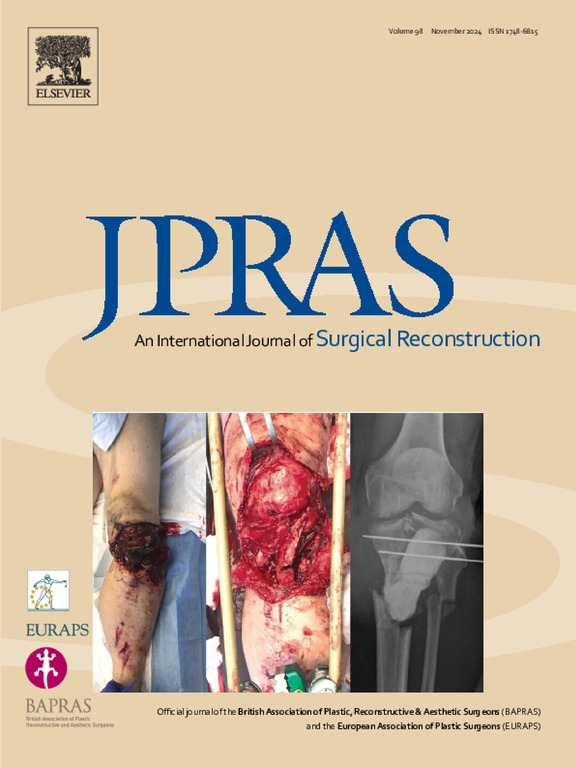Three-dimensional facial soft-tissue changes after L-shaped reduction malarplasty: A pilot retrospective study
IF 2
3区 医学
Q2 SURGERY
Journal of Plastic Reconstructive and Aesthetic Surgery
Pub Date : 2025-03-27
DOI:10.1016/j.bjps.2025.03.051
引用次数: 0
Abstract
Purpose
Reduction malarplasty (RM) is a common facial contouring aesthetic procedure in East Asia. However, there is a lack of data on the postoperative changes in soft tissue and patient-reported outcomes. This retrospective study aimed to evaluate the soft-tissue changes and surgical outcomes following L-shaped RM.
Methods
Fifty-five patients who underwent L-shaped RM were enrolled and 55 patients who underwent genioplasty were enrolled as controls. The soft-tissue changes in relation to the underlying skeletal tissue were analyzed using computed tomography (CT) and three-dimensional (3D) stereophotogrammetry images. Patient’s satisfaction and surgical outcomes were investigated using the FACE-Q and Wrinkle Severity Rating Scale (WSRS).
Results
In the RM group, the soft tissue in zygoma (S2), zygomatic arch (S3), and upper cheek (S5) regions showed a significant inward reduction postoperatively (p<0.001), while the paranasal region (S4) showed a significant outward augmentation (p<0.001). Compared with the control group, the postoperative soft-tissue changes in S2, S3, S4, and S5 demonstrated significant differences in the RM group (p<0.001). The postoperative skeletal-tissue changes in the upper zygoma (B2), zygomatic arch (B3), and lower zygoma (B5) regions exhibited a significant decrease (p<0.001). Significant correlation was observed between the soft and hard tissue changes in B2, B3, and B5 regions (p<0.001). Additionally, patients demonstrated significant postoperative improvement in satisfaction with appearance, although 6 patients’ WSRS grade increased by one-grade.
Conclusion
Following RM, the soft tissue in surgical regions showed inward depression, while the paranasal soft tissue protruded outward, indicating that the soft tissue exhibited a certain degree of sagging. Although the severity of nasolabial folds increased in some patients, the patient’s self-evaluation of aesthetics remained unaffected. The findings suggest that surgeons should consider skeletal and soft-tissue changes when planning RM, and patients should also be informed about the potential postoperative soft-tissue changes to effectively manage their expectations.
l型复位颧成形术后三维面部软组织改变:一项前瞻性回顾性研究
目的在东亚地区,整形术是一种常见的面部整形手术。然而,缺乏关于术后软组织变化和患者报告结果的数据。本回顾性研究旨在评估l型RM术后的软组织变化和手术结果。方法55例行l型肾移植的患者和55例行genplasty的患者作为对照。使用计算机断层扫描(CT)和三维立体摄影测量图像分析软组织相对于底层骨组织的变化。采用FACE-Q和皱纹严重程度评定量表(WSRS)调查患者满意度和手术结果。结果RM组颧骨区(S2)、颧弓区(S3)、上颊区(S5)软组织术后明显向内缩小(p < 0.001),鼻副区(s < S4)明显向外增大(p < 0.001)。与对照组相比,RM组术后S2、S3、S4、S5的软组织变化具有显著性差异(p<0.001)。术后上颧骨(B2)、颧弓(B3)和下颧骨(B5)区域的骨组织变化明显减少(p<0.001)。B2、B3和B5区软硬组织变化之间存在显著相关性(p<0.001)。此外,患者术后对外观的满意度有显著改善,尽管6例患者的WSRS评分增加了1级。结论RM术后手术区软组织向内凹陷,鼻旁软组织向外突出,软组织有一定程度的下垂。虽然部分患者鼻唇皱襞的严重程度有所增加,但患者对美学的自我评价并未受到影响。研究结果表明,外科医生在计划RM时应考虑骨骼和软组织的变化,患者也应了解潜在的术后软组织变化,以有效地管理他们的期望。
本文章由计算机程序翻译,如有差异,请以英文原文为准。
求助全文
约1分钟内获得全文
求助全文
来源期刊
CiteScore
3.10
自引率
11.10%
发文量
578
审稿时长
3.5 months
期刊介绍:
JPRAS An International Journal of Surgical Reconstruction is one of the world''s leading international journals, covering all the reconstructive and aesthetic aspects of plastic surgery.
The journal presents the latest surgical procedures with audit and outcome studies of new and established techniques in plastic surgery including: cleft lip and palate and other heads and neck surgery, hand surgery, lower limb trauma, burns, skin cancer, breast surgery and aesthetic surgery.

 求助内容:
求助内容: 应助结果提醒方式:
应助结果提醒方式:


